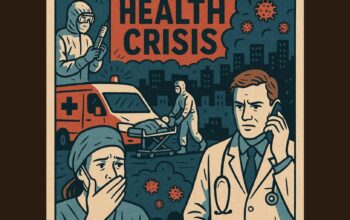by
Amid challenges with seasonal allergies, pollution, and environmental injustices, indoor air quality (IAQ) remains a significant public health issue in the nation’s capital.
Many District residents reside in old, low-ventilated buildings, where heating and cooking appliances such as gas stoves are prevalent. Lacking sufficient financial resources, some residents report the inability to repair and upkeep ventilation systems. As a result, these systems may release pollutants directly into homes and workspaces.
“Indoor air pollution is associated with a multitude of respiratory effects across the lifespan, including impaired lung development in childhood, greater risk for acute lower respiratory tract infections, risk for developing chronic lung disease, and increased morbidity related to asthma and COPD,” according to the National Institutes of Health (NIH).
Populations such as children, older adults, individuals with preexisting conditions, and households of low socioeconomic status are often exposed to higher levels of indoor pollutants.
“Both short and long-term exposure to indoor air pollution can cause a range of health issues, including respiratory diseases, heart disease, cognitive deficits, and cancer. WHO estimates 3.8 million people worldwide die every year from illnesses attributable to harmful indoor air from dirty cookstoves and fuel”, a study from the National Institutes for Environmental Health Sciences details.
Low-Income Communities and Higher Levels of Indoor Air Contaminants
Financial inequity plays a key role in the level of air contaminants found in homes and the workplace.
Low-income individuals are more likely to live in older housing developments. Due to aging infrastructure, these dwellings are more prone to issues such as mold, pests, and inadequate ventilation, which are key contributors to poor indoor air quality.
Geographic location also greatly affects the quality of air in homes and workplaces.
Low-income neighborhoods are often located near major roadways, industrial areas, or other sources of pollution, leading to higher levels of outdoor air pollution that directly infiltrate the air inside homes and workspaces.
“Transportation-related emissions are a leading contributor to air pollution. Polluted air from these emissions irritates the lungs of people who have asthma and makes their asthma worse,” said Kenneth Mendez, CEO of the Asthma and Allergy Foundation of America.
Employment is also a factor, as residents of underserved communities are more likely to work in jobs that expose them to pollutants, such as construction, cleaning, cooking, and waste management. Each day, these pollutants are brought back into the home.
Poor Air Quality Leads to Uptick in Emergency Care
In neighborhoods like Wards 7 & 8, older homes, deteriorating infrastructure, and proximity to major traffic thoroughfares create an ideal environment for pollutants to thrive, causing a direct uptick in respiratory-based illnesses and infections, including asthma.
Dr. Janet Phoenix, a public health expert and longtime advocate for childhood asthma solutions, told The Informer there are various reasons why young people develop immune challenges.
“When a young child is exposed to a lot of pests or mold, then they can develop an allergy to that, which can change the way their immune system develops,” Phoenix explained. “And that change is permanent. It’s something that they carry around with them for the rest of their lives.”
While residents may have access to emergency care, long-term healthcare management for asthma and respiratory illnesses often requires ongoing monitoring and medication.
Without the financial means to consistently access medical care or invest in home improvements, many D.C. residents struggle to effectively manage respiratory-based illnesses, leading to more frequent emergency room visits and hospitalizations.
“Children with asthma are at increased risk of unscheduled physician visits, emergency room visits, and hospitalizations when exposed to…allergens in the home,” a report from the National Institutes of Health on Housing and Asthma Disparities details.
Simple Strategies for Improving Indoor Air Quality
While broader policy interventions are necessary to address housing conditions and healthcare access, there are simple, proactive steps that can help residents mitigate the impact of poor indoor air quality.
Harold Wimmer, National President and CEO of the American Lung Association, emphasizes that “families can take simple steps to protect themselves from indoor air pollution, including ensuring they have a carbon monoxide detector and using a vent hood or opening a window when cooking.” Other simple steps to protect homes and workspaces include:
- Clean Air Vents and HVAC Systems: Regularly cleaning air ducts and HVAC systems can prevent the buildup of dust, mold, and other allergens. Keeping air vents clear of furniture and debris also helps improve ventilation and air circulation. Those living in apartments may even request periodic vent cleaning services from their housing providers, often at no cost to the tenant.
- Dust and Vacuum Regularly: Frequent dusting and vacuuming with a HEPA filter can help reduce allergens like pet dander, dust mites, and pollen. This simple task can significantly reduce the amount of dust and particulate matter in the home.
- Use Air Purifiers: High-quality air purifiers equipped with HEPA filters can capture airborne allergens and pollutants, improving overall air quality in homes. Air purifiers are particularly useful in high-risk areas where pollutants accumulate quickly.
- Fix Leaks and Seal Gaps: Ensuring that windows and doors are properly sealed helps prevent outdoor pollutants from entering the home and reduces moisture buildup that can encourage mold growth.
- Control Humidity Levels: Using dehumidifiers or air conditioners to maintain optimal humidity levels (between 30-50%) can prevent mold growth and reduce the concentration of dust mites.
- Minimize Chemical Exposure: Reducing the use of cleaning products that contain volatile organic compounds (VOCs), such as certain air fresheners, paints, and cleaners, can decrease the number of irritants in the air. Opting for natural or low-VOC alternatives helps improve IAQ.
“Americans, on average, spend approximately 90% of their time indoors, where the concentrations of some pollutants are often 2 to 5 times higher than typical outdoor concentrations,” according to the Environmental Protection Agency (EPA).
Taking proactive steps to improve air quality in homes and workplaces can significantly reduce respiratory triggers and foster a healthier environment for our homes, health, families, and the planet.
Source: Published without changes from Washington Informer Newspaper




